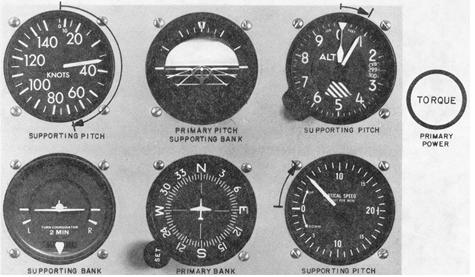
The procedures and techniques described here should be modified as necessary to conform with those set forth in the operating instructions for the particular helicopter flown.
Adjust the miniature aircraft of the attitude indicator as appropriate for the aircraft being flown. After the helicopter is aligned with the runway or takeoff pad, to prevent forward movement of a helicopter equipped with a wheel-typed landing gear, set the parking brakes or apply the toe brakes. if the parking brake is used, it must be unlocked after the takeoff has been completed. Apply sufficient friction to the collective pitch control to minimize overcontrolling and to prevent creeping. Excessive friction should be avoided since this will limit collective pitch movement.
After checking all instruments for indications, start the takeoff by applying collective pitch and a predetermined power setting (normally 10 percent torque above hover power - but not exceeding maximum allowable power). Add power smoothly and steadily to gain airspeed and altitude simultaneously, and to prevent settling to the ground. As power is applied and the helicopter becomes airborne, pedals are used initially to maintain the desired heading. At the same time, apply forward cyclic to begin the acceleration to climbing airspeed. During the initial acceleration, the pitch attitude of the helicopter, as read on the attitude indicator, should be one to two bar widths low. The primary and supporting instruments after becoming airborne are illustrated in Figure 6-14. As the airspeed increases to the appropriate climb airspeed, adjust pitch gradually to climb attitude (see Figure 6-9). As climb airspeed is reached, reduce power to the climb power setting and transition to a fully coordinated straight climb
Figure 6-14. Instrument indications during instrument takeoff.
 |
During the initial climb-out, minor heading corrections should be made with pedals only until sufficient airspeed is attained to transition to fully coordinated flight. Throughout the instrument takeoff, instrument cross-check and interpretations must be rapid and accurate, and aircraft control positive and smooth.
Common errors during instrument takeoffs.
1. Failure to maintain-heading.
2. Overcontrolling pedals.
3. Failure to use required power.
4. Failure to adjust pitch attitude as climbing airspeed is
reached.
Autorotations
Both straight-ahead and turning autorotations should be practiced by reference to instruments. This training will ensure that you can take prompt corrective action to maintain positive aircraft control in the event of power failure.
To enter autorotation, reduce collective pitch smoothly to maintain a safe rotor RPM and apply pedal trim to keep the ball of the turn coordinator centered. The pitch attitude of the helicopter should be approximately level as shown by the attitude indicator. The airspeed indicator is the primary pitch instrument and should be adjusted to the recommended autorotation speed. The heading indicator is primary for bank in a straight-ahead autorotation. In a turning autorotation, a standard rate turn should be maintained by reference to the miniature aircraft of the turn coordinator.
A practice instrument autorotation must be terminated in a power recovery performed in accordance with the procedure recommended for the helicopter being flown.
Common Errors During Autorotations.
1. Uncoordinated entry due to improper pedal trim.
2. Poor airspeed control due to improper pitch attitude.
3. Poor heading control in straight-ahead autorotations.
4. Failure to maintain proper rotor RPM.
5. Failure to maintain standard rate turn during turning autorotations.